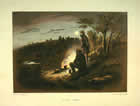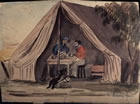Many a hearty laugh do I get at the ridiculous figure cut by some of these young fellows when officiating in what I may term the woman department …
F. Hobson
Of course, diggers hardly made their new homes in pristine wilderness. Newcomers often compared the mining-ravaged landscape to a battleground or graveyard – ‘a burying ground with all new graves just opened.’ But the land was also teeming with life, ‘like a country fair’ or ‘the races’, as miners worked and set up tent. In an attempt to maintain some sanitary conditions, tents had to be pitched twenty feet apart and the same distance from a creek. Tiny single-digger tents with barely enough room to sleep in could be found next door to tents that housed groups of five or six and were high enough to stand up in. There were idiosyncrasies and, sometimes vast distinctions created by wealth, but tents were typically canvas thrown across a timber-frame and then pegged to the ground over a dirt floor. Open-air fires were initially used for cooking and warmth. Autumn rains and the first winter (of 1852) caused many diggers to re-assess their living conditions. Some added mud-brick fireplaces and chimneys to their tents and/or clad them with slabs or bark, and a few constructed crude huts. A sketch by Eugene von Guerard depicts the primitive interior of such accommodation in 1853: there’s quite a substantial fire-place at one end of his tent while a rustic bed and table and log to sit on constitute the ‘furnishings’.
For diggers, the sort of living conditions depicted in von Guerard’s sketch was a great improvement, but newcomers had a different perspective. In 1854, Emily Skinner was dismayed when first confronted with the basic bark hut she was to ‘keep’ for her husband on the goldfields, but admitted ‘it was unusually good for the time and place, as most people lived in tents.’
It was noted by contemporaries that women added a certain level of ‘civilization and womanly refinement’ to domestic life. However, early goldfields households were commonly exclusively male and men had to perform what was traditionally female work. The men of a party often took it in turns to cook and keep tent – to do ‘all those nameless things that one never thought of at home, because they never come under our notice’ as one male contemporary observed of this novel situation.






